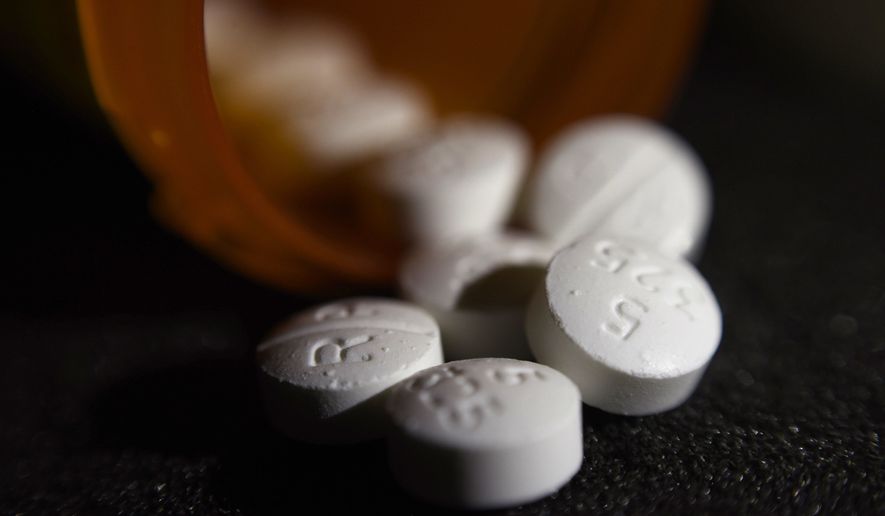Drug overdoses continued to soar in 2016, claiming more than 63,000 lives as deaths tied to fentanyl skyrocketed, making it the deadliest opioid for the first time, the Centers for Disease Control and Prevention said Thursday.
The CDC said more than 42,000 of the deaths were tied to some form of opioids — a 28 percent increase from 33,000 in 2015. Drug-overdose deaths of any kind rose by 21 percent.
Government officials and advocates say the opioids problem continued to rage in 2017, underscoring the huge challenge before Congress and President Trump, who recently declared the opioid crisis to be a public health emergency.
Experts and law enforcement say the surge in fentanyl is incredibly daunting. Drug dealers are obtaining the powerful synthetic and its analogs from clandestine labs in China and Mexico, providing a bigger high but killing off their own customers. First responders can overdose just from coming in contact with the powerful drugs.
The CDC said the number of deaths tied to fentanyl and related synthetics jumped from about 9,500 in 2015 to 19,400 in 2016, eclipsing deaths involving heroin (about 15,500) and prescription painkillers (14,500). Some overdose deaths involve multiple drugs.
Advocates and lawmakers from hard-hit states said the CDC’s findings should compel the government to do more to combat the crisis.
SEE ALSO: Justice Department creates new opioid enforcement position
“Since President Trump declared a public health emergency this fall, the administration has failed to implement real evidence-based solutions to the crisis or find ways to use existing dollars more efficiently. The public health emergency declaration means nothing unless it is coupled with specific responsibilities, deadlines, and action plans,” said Gary Mendell, CEO of Shatterproof, a nonprofit he founded to erase stigma around the opioids problem and spare families the pain he felt when he lost his son, Brian, to addiction in 2011.
The Justice Department on Thursday said it is beefing up its response to the opioids crisis. It announced Thursday the creation of a new senior level position tasked with overseeing efforts to combat the nationwide opioid epidemic.
Previously, Attorney General Jeff Sessions announced a directive requiring each U.S. Attorney’s Office to appoint an opioid coordinator who will oversee the intake of all cases involving opioids, heroin and fentanyl. The coordinator will also be tasked with overseeing task forces that will identify relevant cases, organizing training for prosecutors on opioid issues, and tracking statistics on prosecutions in their district.
Justice Department also announced it would provide $12 million in funding for state and local law enforcement that will be used for drug investigations involving heroin, opioid or methamphetamine.
Still, lawmakers from hard-hit states say Mr. Trump is falling short, reaching for emergency powers but leaving it to Congress to dedicate new funding to the fight.
Lawmakers are scrambling to pass a stopgap funding bill and avoid a government shutdown this weekend, when spending authority expires. As a result, hard decisions about opioids funding will likely be punted to January.
West Virginia, a state reeling from the prescription painkiller and heroin epidemic, had by far the worst overdose death rate in 2016, at 52 per 100,000 people, the CDC reported.
It was followed by Ohio, New Hampshire, and Pennsylvania, which had rates in the high 30s.
“This report is yet another painful reminder of how much work we still must do to save lives and turn the tide of the opioid crisis,” said Sen. Maggie Hassan, New Hampshire Democrat. “Congress must act now to provide additional federal resources to strengthen treatment, prevention, recovery, and law enforcement efforts and give those on the front lines the support they need to fight this epidemic. This is not a partisan issue.”
States say they desperately need the help.
A “tsunami of opioid-affected children” is flooding Ohio’s foster-care services, stretching agency budgets, an advocacy group said Thursday.
The Public Children Services Association of Ohio said the state was a leader in reducing the number of children in out-of-home care during the last decade, but then the 2008 financial meltdown and the opioids crisis hit. More than 15,500 children are in state-agency custody, up from about 12,600 in late 2013.
“Many of these kids watched their parents overdose or die,” said PCSAO Executive Director Angela Sausse. “They are missing milestones with their families such as birthday parties and ringing in the New Year, and many are staying in care longer due to their parents’ relapsing.”
• Tom Howell Jr. can be reached at thowell@washingtontimes.com.
• Andrea Noble can be reached at anoble@washingtontimes.com.




Please read our comment policy before commenting.